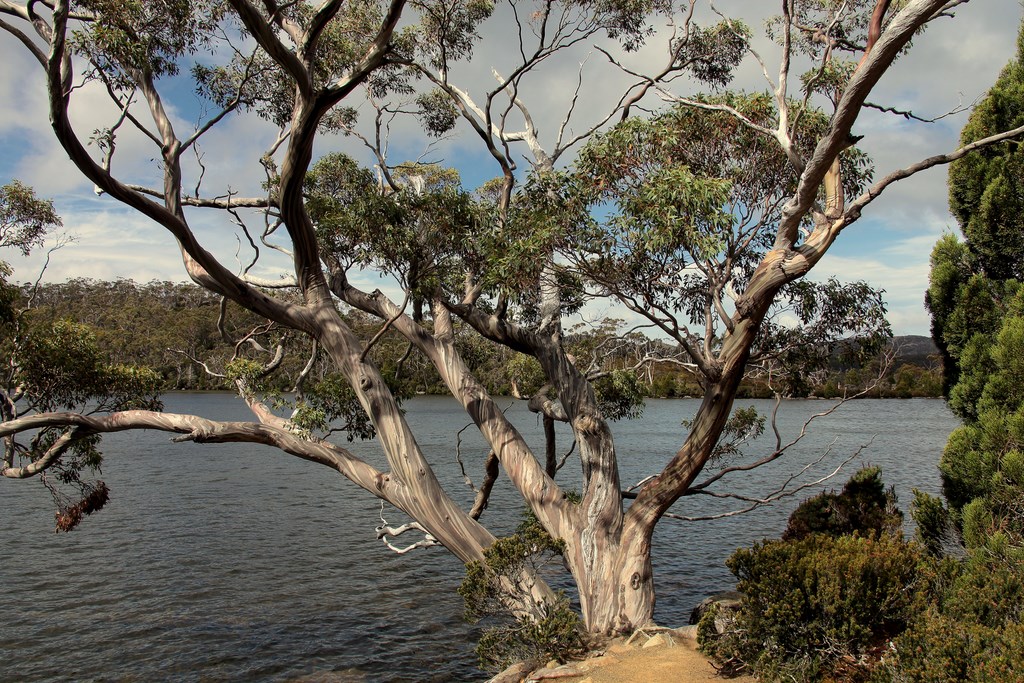EUCALYPTUS COCCIFERA DOBSON LAKE
Eucalyptus coccifera (Tasmanian snow gum "gommier des neiges tasmanien" ou Mount Wellington Peppermint) est une espèce d'arbres endémique de Tasmanie, Australie. Il présente une forme arbustive à la marge des Massifs Centraux. Il pousse dans les régions doléritiques subalpines.
L'espèce s'hybride avec Eucalyptus amygdalina et Eucalyptus pauciflora.
--------------------------------------------
Eucalyptus coccifera, otherwise known as the Tasmanian snow gum, is a flowering evergreen of the myrtle family, Myrtaceae.
Eucalyptus coccifera is a member of the peppermint group (series Piperitae) within subgenus Eucalyptus (formerly Monocalyptus). It is endemic to southern Tasmania - Australia, where it generally occupies sub-alpine habitats above 800 metres in altitude.
Description
Eucalyptus coccifera grows as a tall branching shrub or small tree, typically reaching up to 15 metres in height. The bark is smooth and light grey to white, with streaks of tan. Adult leaves are alternate, petiolate and lanceolate. The leaves are usually glaucous, yet still green, and possess a characteristic crimson hook at the tip. The flower buds of Eucalyptus coccifera are usually very glaucous, ribbed and possess a wrinkly operculum, which is shed when the inflorescences emerge. The buds generally occur in umbels of greater than 7 (typical of subgenus Eucalyptus), however the Mt. Wellington population possess only 3 buds per umbel. Eucalyptus coccifera fruit, like all eucalypts, occurs as woody capsules. The capsules are cup shaped, often glaucous and have a wide, flattened disc. Adult leaves and capsules of Eucalyptus cocciferaThe juvenile foliage contrasts with the adult form in many respects. Juvenile leaves are opposite, sessile (lacking a petiole), round, blue-green and permanently glaucous, but they do possess a small crimson tip. Juvenile branchlets have crimson stems with conspicuous projecting oil glands.
Reproduction and Propagation
Eucalyptus flower buds generally take around a year to fully develop, however development takes longer in Eucalyptus coccifera and other high altitude species. Insects and birds pollinate the emergent flowers, and fertilization can take up to 20 days after pollination. Eucalyptus coccifera flowering typically occurs between November and February. After fertilization, the hard woody capsule develops. Seeds are released through the capsule valves, which open when the capsule dries. This drying out is either caused by extreme heat and drought, or by fire. Dispersal of seed relies partially on wind, but mostly on gravity: the seeds will usually fall within a couple of metres of the parent tree. Eucalyptus coccifera is also known to regenerate from underground lignotubers after fire.
Distribution and Habitat
Eucalytpus coccifera is endemic to Tasmania, and is the dominant species of many exposed, rocky, dolerite rich sub-alpine regions in Tasmania’s south and Central Plateau.
--------------------------------------------
Eucalyptus coccifera, otherwise known as the Tasmanian snow gum, is a flowering evergreen of the myrtle family, Myrtaceae.
Eucalyptus coccifera is a member of the peppermint group (series Piperitae) within subgenus Eucalyptus (formerly Monocalyptus). It is endemic to southern Tasmania - Australia, where it generally occupies sub-alpine habitats above 800 metres in altitude.
Description
Eucalyptus coccifera grows as a tall branching shrub or small tree, typically reaching up to 15 metres in height. The bark is smooth and light grey to white, with streaks of tan. Adult leaves are alternate, petiolate and lanceolate. The leaves are usually glaucous, yet still green, and possess a characteristic crimson hook at the tip. The flower buds of Eucalyptus coccifera are usually very glaucous, ribbed and possess a wrinkly operculum, which is shed when the inflorescences emerge. The buds generally occur in umbels of greater than 7 (typical of subgenus Eucalyptus), however the Mt. Wellington population possess only 3 buds per umbel. Eucalyptus coccifera fruit, like all eucalypts, occurs as woody capsules. The capsules are cup shaped, often glaucous and have a wide, flattened disc. Adult leaves and capsules of Eucalyptus cocciferaThe juvenile foliage contrasts with the adult form in many respects. Juvenile leaves are opposite, sessile (lacking a petiole), round, blue-green and permanently glaucous, but they do possess a small crimson tip. Juvenile branchlets have crimson stems with conspicuous projecting oil glands.
Reproduction and Propagation
Eucalyptus flower buds generally take around a year to fully develop, however development takes longer in Eucalyptus coccifera and other high altitude species. Insects and birds pollinate the emergent flowers, and fertilization can take up to 20 days after pollination. Eucalyptus coccifera flowering typically occurs between November and February. After fertilization, the hard woody capsule develops. Seeds are released through the capsule valves, which open when the capsule dries. This drying out is either caused by extreme heat and drought, or by fire. Dispersal of seed relies partially on wind, but mostly on gravity: the seeds will usually fall within a couple of metres of the parent tree. Eucalyptus coccifera is also known to regenerate from underground lignotubers after fire.
Distribution and Habitat
Eucalytpus coccifera is endemic to Tasmania, and is the dominant species of many exposed, rocky, dolerite rich sub-alpine regions in Tasmania’s south and Central Plateau.
